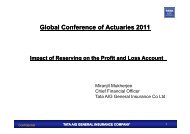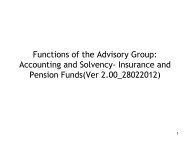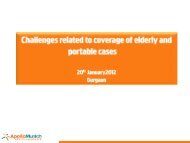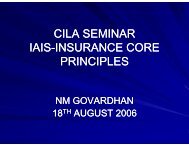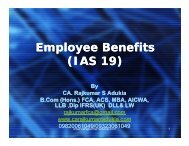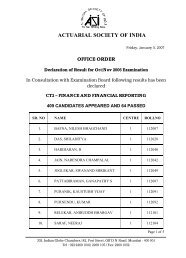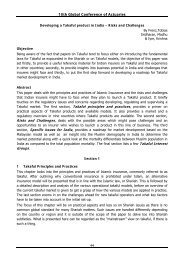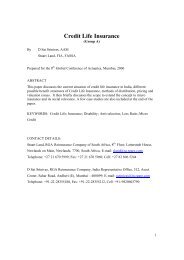Miranjit Mukherjee - Actuarial Society of India
Miranjit Mukherjee - Actuarial Society of India
Miranjit Mukherjee - Actuarial Society of India
Create successful ePaper yourself
Turn your PDF publications into a flip-book with our unique Google optimized e-Paper software.
TATA AIG GENERAL INSURANCE<br />
COMPANY LTD<br />
IFRS 4 / IND AS 104 – As applicable to<br />
General Insurance Companies<br />
MIRANJIT MUKHERJEE<br />
1 1- 1 -
AGENDA<br />
1. Background <strong>of</strong> IFRS 4<br />
2. Background <strong>of</strong> IND AS 104<br />
3. What is IFRS 4 / IND AS 104<br />
4. Recognition and measurement under IND-AS 104<br />
5. Insurance Contracts<br />
6. Examples <strong>of</strong> Insurance Contracts<br />
7. Liability Adequacy test and examples<br />
8. Disclosures principles and summary<br />
9. Comparison <strong>of</strong> IND AS 104 vs current requirements<br />
10. Balance Sheet – IND AS 104<br />
11. Additional disclosures under IND AS 104<br />
12. Key issues for implementation<br />
13. Impact <strong>of</strong> IND AS 104 / IFRS on general insurers<br />
14. Terms Used<br />
2
IFRS 4 – Phase I – BACKGROUND<br />
April 2001<br />
Comprehensive insurance contracts project carried over<br />
from IASC to new IASB<br />
May 2002<br />
Short-term insurance contracts project split <strong>of</strong>f from<br />
comprehensive project<br />
July 2003<br />
Exposure Draft ED 5 Insurance Contracts<br />
31 st Mar 2004<br />
IFRS 4 Insurance Contracts<br />
1 st Jan 2005<br />
Effective date <strong>of</strong> IFRS 4<br />
3
IND AS 104 – BACKGROUND<br />
2009<br />
IRDA issues exposure draft on IFRS Compliance<br />
2010<br />
Exposure Draft AS 39 on Insurance Contracts<br />
25 Feb 2010<br />
MCA notifies 35 IFRS (IND AS) incl IND AS 104<br />
1 April 2012<br />
Insurance cos prepare opening bal sheet as per IND AS<br />
Date - ?<br />
Preparation <strong>of</strong> opening bal sheet as per IND AS<br />
4
WHAT IS IFRS 4 – PHASE I – IND AS 104<br />
Interim standard - focused primarily on disclosures and classification <strong>of</strong><br />
insurance contracts.<br />
Introduces a definition for an insurance contract based on the contract<br />
containing significant insurance risk.<br />
Required only limited changes to existing accounting practices for insurance<br />
contracts and extensive disclosures.<br />
IFRS 4 does not affect the business fundamentals since there is<br />
‣ No change in the underlying transactions<br />
‣ No change in real cash flow<br />
5
RECOGNITION AND MEASUREMENT UNDER IND AS 104<br />
In most respects, IND AS 104 allows an entity to continue to account for insurance contracts<br />
under its previous accounting policies.<br />
However, the standard makes some limited improvements to accounting for insurance<br />
contracts<br />
Liabilities only on existing contracts : Catastrophe provisions and equalization provisions are<br />
not permitted. They are not liabilities.<br />
Liability Adequacy Test : The adequacy <strong>of</strong> insurance liabilities must be tested at the end <strong>of</strong><br />
each reporting period. The liability adequacy test is based on current estimates <strong>of</strong> future cash<br />
flows. Any deficiency is recognized in pr<strong>of</strong>it or loss.<br />
Impairment testing : Furthermore, reinsurance assets are tested for impairment.<br />
No <strong>of</strong>fsetting : Insurance liabilities are presented without <strong>of</strong>fsetting them against related<br />
reinsurance assets.<br />
No <strong>of</strong>fsetting : Insurance expense or income against related reinsurance income or expense.<br />
6
INSURANCE CONTRACTS<br />
IND AS 104 covers insurance contracts<br />
It applies to insurance contracts where policy holders pass insurance risk to insurance companies<br />
OR where insurers pass insurance risk to re-insurers<br />
What is an insurance contract<br />
In the contract one party accepts significant insurance risk from another party<br />
The party accepting insurance risk agrees to compensate the policy holder<br />
If a specified uncertain future event affects the policyholder<br />
What is an insurance risk<br />
The risk in the contract must be insurance risk, which is any risk except for financial risk<br />
This specified uncertain future event is known as the “insured event” while the uncertain future event<br />
that is covered by an insurance contract creates “insurance risk”.<br />
Uncertainty<br />
Uncertainty is the essence <strong>of</strong> an insurance contract . At least one <strong>of</strong> the following is uncertain at the<br />
inception <strong>of</strong> the contract :<br />
Whether an insured event will happen<br />
When will it occur<br />
How much the insurer needs to pay<br />
7
INSURANCE CONTRACTS<br />
Insurance Contract<br />
Insurer accepts Insurance Risk<br />
Significant Risk<br />
Insurer accepts Significant Risk<br />
No numerical range fixed for what is significant risk<br />
Meaning <strong>of</strong> significant : Payment <strong>of</strong> significant additional benefit<br />
Another Party<br />
Insurer must accept risk from another party .<br />
Insurer must be separate from the policy holder .<br />
Accordingly self insurance is not an insurance contract as per IND AS 104<br />
8
SIGNIFICANT INSURANCE RISKS<br />
INSURANCE RISK<br />
The underlying tenet behind insurance transactions.<br />
The purpose <strong>of</strong> this action is to take a specific risk, which is detailed in the insurance<br />
contract, and pass it from one party who does not wish to have this risk (the insured) to a party<br />
who is willing to take on the risk for a premium (the insurer).<br />
RISK TRANSFER<br />
Underwriting risk<br />
Risk transfer<br />
Conditions<br />
Timing Risk<br />
Amount Risk<br />
9
INSURANCE CONTRACTS<br />
Significant insurance risk<br />
Insurance Contract<br />
Contract<br />
Insignificant insurance risk<br />
Investment Contract<br />
NB : IFRS 4 applies to insurance contracts not to insurance companies<br />
10
EXAMPLES OF INSURANCE CONTRACTS - IND AS 104<br />
Insurance contracts covered<br />
Contracts to be excluded<br />
Theft / Damage to property<br />
Product / Pr<strong>of</strong>essional Liability<br />
Accident and Health<br />
Marine<br />
Engineering<br />
Product Warranty ( excl issued<br />
by manufacturer / dealer / retailer )<br />
Title Insurance<br />
Travel Insurance<br />
Reinsurance Contracts<br />
Self Insurance<br />
Credit related guarantee<br />
Weather derivative<br />
Catastrophic Bonds<br />
11
LIABILITY ADEQUACY TEST<br />
Must assess at each reporting date whether recognised insurance liabilities are adequate<br />
based on current estimates <strong>of</strong> future cash flows under insurance contracts.<br />
The assessment must use current assumptions and consider all contractual cash flows.<br />
If existing accounting policies include an assessment that meets<br />
the specified minimum requirements, no further action required.<br />
If not ?<br />
If no sufficient assessment, the carrying amount <strong>of</strong> the liability must<br />
be tested and, if necessary increased<br />
12
HOW DO YOU CARRY OUT LIABILITY ADEQUACY TEST<br />
If the present value <strong>of</strong> the expected cash flows arising out <strong>of</strong> future claims exceeds the<br />
unearned premium liability then the unearned premium liability is deficient . The recognized<br />
deficiency has to be recorded in the income statement .<br />
This should not be an issue in <strong>India</strong> as insurers are already required to create a<br />
premium deficiency in their accounts in the current accounting principles .<br />
13
EXAMPLES OF LIABILITY ADEQUACY TESTS<br />
Royal Sun Alliance<br />
At each balance sheet date an assessment is made <strong>of</strong> whether the provisions for unearned premiums are adequate.<br />
A separate provision is made, based on information available at the balance sheet date, for any estimated future<br />
underwriting losses relating to unexpired risks. The provision is calculated after taking into account future investment<br />
income that is expected to be earned from the assets backing the provisions for unearned premiums (net <strong>of</strong> deferred<br />
acquisition costs). The unexpired risk provision is assessed in aggregate for business classes which, in the opinion<br />
<strong>of</strong> the directors, are managed together.<br />
Zurich<br />
A provision should be made for unexpired risks where the expected value <strong>of</strong> claims and expenses attributable to the<br />
unexpired periods <strong>of</strong> policies in force at the balance sheet date exceeds the unearned premiums provision in relation<br />
to such policies after the deduction <strong>of</strong> any deferred acquisition costs. The need for an unexpired risk provision has<br />
been considered separately by reference to classes <strong>of</strong> business that are managed together, after taking into account<br />
the relevant investment returns. An unexpired risk provision was not found necessary for any business classes and<br />
therefore a provision is not raised in the accounts.<br />
SCOR RE<br />
For the Non Life segment the test is performed in the event the ultimate underwriting combined ratio is in excess <strong>of</strong><br />
100% to the unearned premium reserve net <strong>of</strong> deferred acquisition costs . The liability adequacy test is performed on<br />
the level <strong>of</strong> the actuarial segment and then aggregated at the entity level .<br />
14
PRINCIPLES OF DISCLOSURES UNDER IFRS 4<br />
Disclosure is particularly important for information relating to insurance<br />
contracts, as entities can continue to use local GAAP accounting policies for<br />
measurement.<br />
IFRS 4 has two main principles for disclosure.<br />
‣ Entities should disclose information that identifies and explains the<br />
amounts in its financial statements arising from insurance contracts.<br />
‣ Information that enables users <strong>of</strong> its financial statements to evaluate the<br />
nature and extent <strong>of</strong> risks arising from insurance contracts.<br />
15
SUMMARY OF DISCLOSURES REQUIRED UNDER IFRS 4<br />
Information that helps<br />
users understand the<br />
amounts in the financial<br />
statements arising from<br />
Insurance contracts<br />
Accounting policies for insurance contracts<br />
Recognized Assets , Liabilities , Income, Expenses and<br />
Cash Flows arising from these contracts<br />
Assumptions that impact value <strong>of</strong> Assets , Liabilities , Income<br />
and Expenses<br />
Historic claims development ( loss development triangle )<br />
Nature and extent <strong>of</strong> risks<br />
arising from Insurance<br />
contracts<br />
Risk management policies and objectives<br />
Information about insurance risk sensitivity and<br />
concentration<br />
Information about credit risk, liquidity risk and market risk<br />
16
EXISTING ACCOUNTING REQUIREMENT VS IND AS 104<br />
ISSUE EXISTING AS PER IND AS / IFRS Ref<br />
1 Financials Revenue A/cs , P/L , B/S , Cash Flow , Notes Income Stat , B/S , SOCE , Cash Flow, Disclosures , Notes<br />
2 Format As laid down by Insurance Act / Regulations No specified format<br />
3 Segments Fire , Marine and Miscellaneous Criteria specified + those reviewed by decision makers 108<br />
4 DAC Not permitted by Regulations IND AS 104 takes reference to DAC 104<br />
5 Investments Debt instruments (HTM ) / Equity (MTM) FVTPL ( MTM ) / HTM / AFS ( MTM )<br />
6 UEPR Minimum as per Sec 64V <strong>of</strong> Insurance Act As per Liability Adequacy Testing ( LAT ) 104<br />
7 UEPR Fire , Marine and Miscellaneous As per Liability Adequacy Testing ( LAT ) 104<br />
8 LAT Premium Deficiency specified by IRDA circular As per IND AS 104 104<br />
9 Solvency Workings as per Insurance Act / Regulations Not clear .<br />
10 Disclosures Disclosures as laid down by Regulations . Detailed disclosures laid down for Insurance transactions / Risks 104<br />
No disclosures on risks<br />
17
BALANCE SHEET UNDER IND AS 104 / IAS 39<br />
Investments<br />
Deferred Tax Asset<br />
Fixed Assets<br />
Cash and Bank Balances<br />
Advances and Other Assets<br />
Reinsurance share <strong>of</strong> insurance liab<br />
ASSETS<br />
Reinsurers<br />
recovery have<br />
to be shown<br />
separately<br />
Share Capital<br />
Reserves and Surplus<br />
Fair Value Change Account<br />
Borrowings<br />
Deferred Tax Liability<br />
Insurance Liabilities - gross<br />
Other Liabilities & provisions<br />
LIABILITIES<br />
Insurance<br />
Liabilities have<br />
to be Grossed<br />
up<br />
INVESTMENTS - EXISTING VALUATION INVESTMENTS - IND AS VALUATION<br />
Debt Instruments Amortised cost Fair value through P&L MTM<br />
Equity Shares MTM Held to Maturity Amortised cost<br />
Available for Sale<br />
MTM<br />
18
ADDITIONAL DISCLOSURES UNDER IND AS 104<br />
<br />
<br />
<br />
<br />
Section on Risk Management<br />
Insurance Risk ( underwriting risk / concentration risk )<br />
Financial Risk<br />
Market Risk ( Interest rate / Currency / Equity )<br />
Credit Risk<br />
Liquidity Risk<br />
Operational Risk<br />
Capital Management<br />
Liability Adequacy Test<br />
Impairment <strong>of</strong> Reinsurance Assets<br />
Loss development triangle<br />
19
KEY ISSUES THAT NEEDS TO BE ADDRESSED<br />
Start date<br />
Date for the opening balance sheet needs to be fixed<br />
Amendment<br />
Amendment required to the Insurance Act / Regulations<br />
F. Statements As per IND AS or existing basis or both<br />
Solvency<br />
Based on existing regulations or IND AS<br />
20
IMPACT OF IND AS 104 / IFRS ON INDIAN GEN INSURERS<br />
Ins Contracts<br />
Not very significant<br />
Disclosures<br />
Significant effort during the earlier years <strong>of</strong> implementation<br />
Investments<br />
Accounting and measurement would have a big impact<br />
LAT<br />
Segment wise LAT would impact solvency<br />
Op Segments<br />
Companies monitor performance on their chosen segments<br />
Solvency<br />
Would be impacted by Investments measurement / LAT<br />
21
TERMS USED<br />
<br />
<br />
<br />
<br />
<br />
<br />
<br />
<br />
<br />
MCA : Ministry <strong>of</strong> Corporate Affairs<br />
DAC : Deferring <strong>of</strong> acquisition costs<br />
LAT : Liability Adequacy Test<br />
URR : Unexpired Risk Reserve<br />
HTM : Held to Maturity<br />
MTM : Mark to Market<br />
AFS : Available for Sale<br />
SOCE : Statement <strong>of</strong> Change in Equity<br />
B/S : Balance Sheet<br />
22




